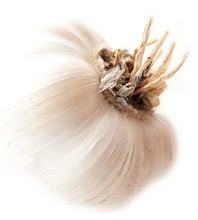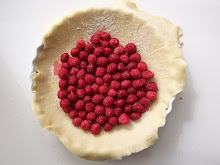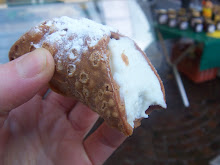 Three days of cured meat. A whole set of new words added to my vocabulary: Prosciutto di Parma, Culatello di Zibello, cotechino, macello... Our cured meat stage begun. We headed off to butcher school, for a demonstration of pork cutting. I prepared myself for the unknown, an uneasy feeling in my stomach...we all squeezed into a narrow cold room containing three butchers, and 2 large meat cuts of a freshly slaughtered pig. I was captured by the artisanship; their skilled hands confidently held the sharp knives, skillfully taking the meat apart into the smallest pieces, divided to separate mounds of fibrous nerves, fat, skin, pork chops, and ham. Working side by side, the butchers were exchanging parts, discarding unwanted pieces, working on different parts in a synchronized rhythm; it was a choreography of dismembering. The aesthetics of butcherism. It was beautiful and fascinating. A bottle of Lambrusco was popped open. Than another. Some grissini sticks, Parmigiano Reggiano wedges, and pork scratching were served. Whilst this feast is going on, the butchers were still chopping the pig into bits. This is all happening on the same table. And apparently, this is lunch. After lunch we headed to a near by industrial pig farm with its own slaughterhouse. I was afraid of this. One by one, in a casual pace, the farmer pushes a pig into a confined cage. The pig is weighed, than enters a room. This is the slaughterhouse. I chose not to view the slaughter. I had no curiosity or desire to witness life perish a living being. Its all very quick and within moments a man drags out a bucket containing the internal discarded parts. A few cars reversed near by and uploaded their trunk with the freshly cut pork. The vapors are visible off the meat cuts, as it is still warm. In the adjacent room we had a demonstration of the preparation of a cotechino. Once again, a bottle of home made Lambrusco was opened. I am in a slaughterhouse drinking wine. This seems to happen quite often.
Three days of cured meat. A whole set of new words added to my vocabulary: Prosciutto di Parma, Culatello di Zibello, cotechino, macello... Our cured meat stage begun. We headed off to butcher school, for a demonstration of pork cutting. I prepared myself for the unknown, an uneasy feeling in my stomach...we all squeezed into a narrow cold room containing three butchers, and 2 large meat cuts of a freshly slaughtered pig. I was captured by the artisanship; their skilled hands confidently held the sharp knives, skillfully taking the meat apart into the smallest pieces, divided to separate mounds of fibrous nerves, fat, skin, pork chops, and ham. Working side by side, the butchers were exchanging parts, discarding unwanted pieces, working on different parts in a synchronized rhythm; it was a choreography of dismembering. The aesthetics of butcherism. It was beautiful and fascinating. A bottle of Lambrusco was popped open. Than another. Some grissini sticks, Parmigiano Reggiano wedges, and pork scratching were served. Whilst this feast is going on, the butchers were still chopping the pig into bits. This is all happening on the same table. And apparently, this is lunch. After lunch we headed to a near by industrial pig farm with its own slaughterhouse. I was afraid of this. One by one, in a casual pace, the farmer pushes a pig into a confined cage. The pig is weighed, than enters a room. This is the slaughterhouse. I chose not to view the slaughter. I had no curiosity or desire to witness life perish a living being. Its all very quick and within moments a man drags out a bucket containing the internal discarded parts. A few cars reversed near by and uploaded their trunk with the freshly cut pork. The vapors are visible off the meat cuts, as it is still warm. In the adjacent room we had a demonstration of the preparation of a cotechino. Once again, a bottle of home made Lambrusco was opened. I am in a slaughterhouse drinking wine. This seems to happen quite often.  On the second day we drove out to a Prosciutto di Parma producer in San Michele Cavana, a picturesque rural setting for producing Parma ham in optimal climate & humidity. On good days, the windows are open to allow the ham to be cured in the fresh cold air... The smell of each and every phase in the production process is still fresh in my head, and nose, with thousands of Prosciuttos cured to perfection. We than drove to a taverna at Torrechiara di Langhiranos. Lunch, respectfully lasted over two hours, and it seems as if everyone's cheeks turned rosy by the end of it..:) This is the kind of stuff you don't even imagine but secretly hope...not to dissimilar to Lambrusco in a slaughterhouse...(which Prosciutto and Lambrusco will always forever be associated with). We enjoyed several types of cured meats, fried bread, two types of ravioli (one stuffed with pumpkin and Amaretti biscuits!!!), Espresso and sweet moist Italian cakes for dessert. All of which went down great with wine.
On the second day we drove out to a Prosciutto di Parma producer in San Michele Cavana, a picturesque rural setting for producing Parma ham in optimal climate & humidity. On good days, the windows are open to allow the ham to be cured in the fresh cold air... The smell of each and every phase in the production process is still fresh in my head, and nose, with thousands of Prosciuttos cured to perfection. We than drove to a taverna at Torrechiara di Langhiranos. Lunch, respectfully lasted over two hours, and it seems as if everyone's cheeks turned rosy by the end of it..:) This is the kind of stuff you don't even imagine but secretly hope...not to dissimilar to Lambrusco in a slaughterhouse...(which Prosciutto and Lambrusco will always forever be associated with). We enjoyed several types of cured meats, fried bread, two types of ravioli (one stuffed with pumpkin and Amaretti biscuits!!!), Espresso and sweet moist Italian cakes for dessert. All of which went down great with wine.  On the third and final day we arrived at Antica Corte Pallavicina in Polesine Parmense. North of Parma, by the river Po, where the climate is humid, Culatello, also known as king of cured pork meat, is cured. The curing techniques and products cured here differ from the types and techniques used to cure meat in the area South of Parma, where the air is dry and cold.
On the third and final day we arrived at Antica Corte Pallavicina in Polesine Parmense. North of Parma, by the river Po, where the climate is humid, Culatello, also known as king of cured pork meat, is cured. The curing techniques and products cured here differ from the types and techniques used to cure meat in the area South of Parma, where the air is dry and cold.The farm grows all its produce, pigs, cows, chicken, geese, that all roam freely, and their food is grown on the premises too, as well as the vegetables and wine. The meat is cured in a beautiful cellar, and the difference between this artisan production of cured meat to the industrial is immediately recognized. On entering the cellar a wonderfully appetizing aroma was present. We were given a demonstration of the preparation of a Culatello, and than had a tasting of the various types of meat cured on the premises, accompanied by four types of Parmigiano Reggiano, distinctly produced by white cows and red cows, as well as the sparkling red wine made from the vines grown on the land. I tried Mariola. And than I had more of it, and than some. It is a type of cooked ham; this was the aristocrat brother of the meat loaf, like I never knew existed. I had experienced meat cured with love. We visited another small artisan producer of various cured meat in the area, before calling it a day, and something funny happened. Similar to the process that occurs when learning a new language, in which the words, sounds and meaning are gradually absorbed until a point of synthesis, when the flood gates open, it all came together. I had heard, seen and tasted so much cured meat, in such a short intensive period, I had acquired a platform of knowledge unto which I could compare, detect and distinguish between various types of meat, productions system types, flavours, colours, aromas and personal preferences. It all made sense now. I came full circle. And I can taste it.








No comments:
Post a Comment